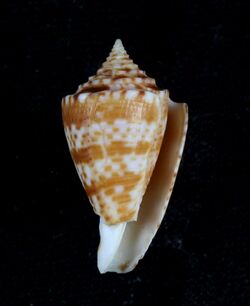Biology:Conasprella wakayamaensis
From HandWiki
Short description: Species of gastropod
| Conasprella wakayamaensis | |
|---|---|

| |
| Apertural view of shell of ''Conasprella wakayamaensis Petuch, 1979, trawled at 150 meters off Aliguay Island in the Philippines | |
| Scientific classification | |
| Domain: | Eukaryota |
| Kingdom: | Animalia |
| Phylum: | Mollusca |
| Class: | Gastropoda |
| Subclass: | Caenogastropoda |
| Order: | Neogastropoda |
| Superfamily: | Conoidea |
| Family: | Conidae |
| Genus: | Conasprella |
| Species: | C. wakayamaensis
|
| Binomial name | |
| Conasprella wakayamaensis (Kuroda, 1956)
| |
| Synonyms[1] | |
| |
Conasprella wakayamaensis is a species of sea snail, a marine gastropod mollusk in the family Conidae, the cone snails and their allies.[1]
Like all species within the genus Conasprella, these snails are predatory and venomous. They are capable of "stinging" humans. Therefore, live ones should be handled carefully or not at all.
Description
The size of the shell varies between 24 mm and 33 mm.
Distribution
This marine species occurs off Taiwan and Japan ; also in the Bismarck Sea off Papua New Guinea.
References
- ↑ 1.0 1.1 Bouchet, P. (2015). Conasprella wakayamaensis (Kuroda, 1956). Accessed through: World Register of Marine Species at http://www.marinespecies.org/aphia.php?p=taxdetails&id=580172 on 2015-03-01
- Tucker J.K. & Tenorio M.J. (2009) Systematic classification of Recent and fossil conoidean gastropods. Hackenheim: Conchbooks. 296 pp.
- Tucker J.K. & Tenorio M.J. (2013) Illustrated catalog of the living cone shells. 517 pp. Wellington, Florida: MdM Publishing.
- Puillandre N., Duda T.F., Meyer C., Olivera B.M. & Bouchet P. (2015). One, four or 100 genera? A new classification of the cone snails. Journal of Molluscan Studies. 81: 1–23
External links
- The Conus Biodiversity website
- Cone Shells – Knights of the Sea
- "Conasprella wakayamaensis" (in en). Gastropods.com. http://www.gastropods.com/5/Shell_5065.shtml.
Wikidata ☰ Q520385 entry
 |



